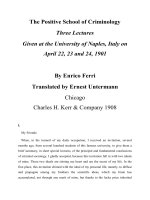The brewing process - The Scandinavian School of Brewing potx
Bạn đang xem bản rút gọn của tài liệu. Xem và tải ngay bản đầy đủ của tài liệu tại đây (1.96 MB, 32 trang )
Den Skandinaviske Bryggerhøjskole
The Scandinavian School of Brewing
The brewing process
The Scandinavian School of Brewing
Axel G. Kristiansen
Axel G. Kristiansen
Den Skandinaviske Bryggerhøjskole
The Scandinavian School of Brewing
Raw Materials
How to start Brewing
Ingredients in brewing process
Wholesome Danish Barley is steeped into water
and germinated into green malt,
which is dried (Killned) into malt.
Den Skandinaviske Bryggerhøjskole
The Scandinavian School of Brewing
Barley
A cross section of
one barley kernel
Den Skandinaviske Bryggerhøjskole
The Scandinavian School of Brewing
Malting - Flowdiagram
Den Skandinaviske Bryggerhøjskole
The Scandinavian School of Brewing
Water as a source
Brewing liquor has to be treated in different ways
before it is suitable for gravity liquor.
Demineralisation:
-ion exchange
- reverse osmosis
Active carbon filtration:
Deaeration:
- boiling
- vacuum treatment
-CO
2
wash
-N
2
wash
Carbonation:
Cooling:
Den Skandinaviske Bryggerhøjskole
The Scandinavian School of Brewing
Brewing Salts
Calcium – Ca
++
Magnesium – Mg
++
Chloride–Cl
-
Sulphate–SO
4
Carbonate – HCO
3
-
Den Skandinaviske Bryggerhøjskole
The Scandinavian School of Brewing
Why do we use hops ?
Bitterness
Aroma
Protein Precipitation
Anti-oxidant
Flavor/Taste Stability
Foam
Foam ClingAntibacterial
Trub Formation
Health
Den Skandinaviske Bryggerhøjskole
The Scandinavian School of Brewing
Hop
Cone
Leaves
(Bract & Bracteoles)
Lupulin
Glands
Resins
Soft Resins Hard Resins
Hop Oils
Polyphenols
Other
Components
Prenylflavonoids
Oxidation Products
Unspecified
Hard Resins
Unspecified
Soft Resins
Beta Acids
Alpha Acids
Xanthohumol
Den Skandinaviske Bryggerhøjskole
The Scandinavian School of Brewing
Brewhouse
The malt is crushed in the brewhouse, mixed
with water and heated gradually to 76 °C in
the mash kettle.
In the mash filter spent grains are separated
from the wort. The spent grains are sold for
cattle fodder.
The clarified wort is boiled in the wort kettle
with hops, which are subsequently separated
Den Skandinaviske Bryggerhøjskole
The Scandinavian School of Brewing
Brewhouse
Brewhouse processes:
• Milling
• Mashing
• Wort recovery (Lautering)
• Wortboiling
• Wort treatment (clarification and cooling)
Den Skandinaviske Bryggerhøjskole
The Scandinavian School of Brewing
Mashing
Purpose:
• Starch into solution
• Enzymatic degradation of starch to maltose
Enzymes:
• Carbohydrate: α-og β-amylases. Amylases breaks
starch into smaller molecules. Typically maltose,
glucose, maltotriose etc.
• β-glucanase breaks glucanes, ea. cellwalls from malt
• Proteinases breaks proteins to amino acids.
Contributes to yeast nutrition.
Infusion /Decoction
Den Skandinaviske Bryggerhøjskole
The Scandinavian School of Brewing
Lauter Tun – traditional/modern
•
•
Recovery
Recovery
of
of
dissolved
dissolved
substances
substances
–
–
”
”
the wort
the wort
”
”
•
•
Disposal
Disposal
of
of
undissolved
undissolved
substances
substances
–
–
”
”
the
the
spent
spent
grains
grains
”
”
Den Skandinaviske Bryggerhøjskole
The Scandinavian School of Brewing
Taste Testing
Thorough routine production control and frequent
laboratory tests during and after the brewing process
ensure that the quality of the beer is consistenly high
Den Skandinaviske Bryggerhøjskole
The Scandinavian School of Brewing
Taste Testing
Tasters
Most people are naturally equipped with an
excellent sense of taste and smell
Important are:
» concentration
» interest
» training
» routine
» age
Den Skandinaviske Bryggerhøjskole
The Scandinavian School of Brewing
Processes in Fermenting & Filtration area
The wort is cooled and pure yeast is added.
Fermentation takes place in vertical outdoor
fermenting tanks. The yeast is removed and the
beer matures in the tank for two to three weeks.
Thereafter the beer is stored at a temperature
of -2°C for at least 24 hours, clarified in
centrifuges, and filtered in candle filters.
Den Skandinaviske Bryggerhøjskole
The Scandinavian School of Brewing
Beer process flow diagram
Den Skandinaviske Bryggerhøjskole
The Scandinavian School of Brewing
Fermentation & Conditioning
• The clear bitter wort is cooled to 14°C and aerated.
• The next processing step involves the growth of yeast,
which is encouraged by the presence of dissolved oxygen.
• The yeast is mixed (pitched) with the wort, and during the
following fermentation the yeast converts fermentable
carbohydrates in the wort into alcohol and carbon dioxide.
• After the primary fermentation (5-8 days) the yeast is
separated from the "green beer", which is stored or
"conditioned" for a certain period of time with a view to
improvement of the flavour and chemical stability of the
beer.
• After stabilisation and filtration the beer is ready for
packaging.
Den Skandinaviske Bryggerhøjskole
The Scandinavian School of Brewing
Wort cooling
Plate Heat Exchangers:
Plate Heat Exchangers:
Found between brewhouse
Found between brewhouse
and fermentation
and fermentation
Den Skandinaviske Bryggerhøjskole
The Scandinavian School of Brewing
Primary Fermentation
1) Yeast strains: Carlsberg 252, Tuborg 112, contract beer 170,
Pripps 180, Abbey Ale 386, Tuborg Wheat 381,
Honey Ale 368
2) Yeast growth
amount of pitching yeast: 10-18 mio/ml wort
yeast pitching procedure
consistency and viability of pitching yeast
wort cooling temperature
wort aeration (amount and time of aeration)
3) Fermentation temperatures during main fermentation
4) Wort composition and original extract in wort
Den Skandinaviske Bryggerhøjskole
The Scandinavian School of Brewing
Secondary Fermentation
(’’Lagring’’)
Recommended temperatures during
fermentation & conditioning:
a) Wort cooling temperature 12° - 13°C
b) Max. fermentation temperature 14° - 16°C
c) Maturation temperature 7° - 8°C
d) Cooling rate from fermentation to
maturation temperature 5°C within 24 h
Den Skandinaviske Bryggerhøjskole
The Scandinavian School of Brewing
Stabilisation
Definition of Stabilisation
The expression stabilisation is used specifically about the
procedure by which the brilliance of the finished beer is
sustained, that is a procedure to avoid or to reduce the
appearance of non-biological haze in the packaged beer during
storage.
By stabilisation we obtain a colloidal stability, also called a
chemical stability, of great importance to the shelf life of the
beer. Unstable beer is cloudy beer !
If the breweries did not use stabilisation, most beers in the world
would appear cloudy at low temperature after a few weeks'
storage.
Den Skandinaviske Bryggerhøjskole
The Scandinavian School of Brewing
.
Tank Farm the brewery
Den Skandinaviske Bryggerhøjskole
The Scandinavian School of Brewing
Beer Filter
Den Skandinaviske Bryggerhøjskole
The Scandinavian School of Brewing
Packaging
Finally, the pure, sparkling beer is transferred to
the high speed packaging-lines.
The picture shows automatic bottling, crowning,
pasteurising, labelling and packing
Processes in Packaging Area
Different packages for Beer
Den Skandinaviske Bryggerhøjskole
The Scandinavian School of Brewing
Bottling Line
Schematic Lay-out
New bottles
Returned bottles
Depalletiser
(Pallets)
PalletiserFilled bottles
in warehouse
Crater
Check
fill-level
Labeller
Crate washer
Decrater Sorter Washer
Inspector
Filler
Crowner
Pasteuriser









